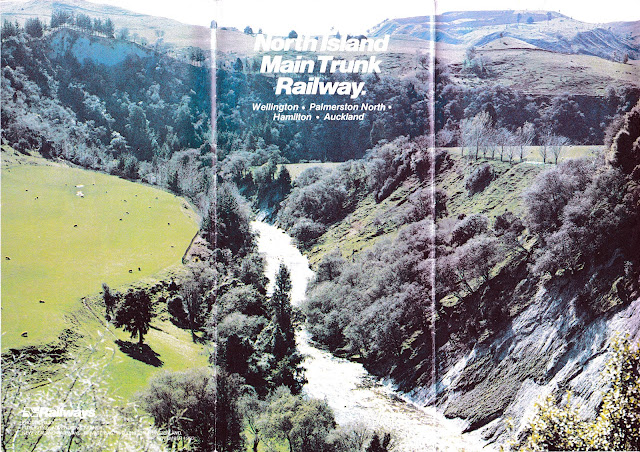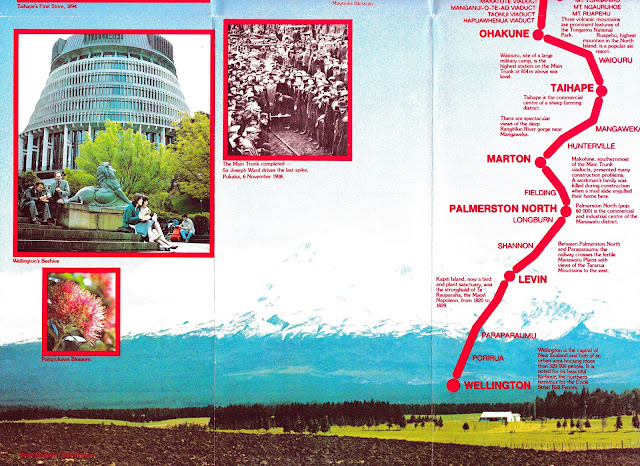 |
| Silver fern leaflet May 1982 |
 |
| Silver fern leaflet May 1982 |
 |
| Silver fern leaflet September 1982 |
 |
| Silver fern leaflet September 1982 |
 |
| Silver fern leaflet February 1984 |
 |
| Silver fern leaflet February 1984 |
 |
| Silver fern leaflet c. 1990 |
 |
| Silver fern leaflet c. 1990 |
Four sets of Silverfern (or Silver Fern?) promotional leaflets highlight some evolution in thinking about the Silverfern railcar service, which unlike many of those published here, still exists in the form of the
Northern Explorer service between Wellington and Auckland (albeit with 40% fewer stops!). With withdrawal of the Silverstar sleeper train in 1979, the Silverfern was the only air-conditioned passenger rail service in New Zealand until the late 1990s when some 56ft carriages were so equipped), and certainly the only long-distance service with arguably modern rolling stock (having been built in 1972, rather than 1937-1945 or consisting of stripped down former railcars from the mid 1950s). Until the AK class passenger cars which were progressively introduced from 2011 (for the Coastal Pacific, Tranz-Alpine and Overlander/Northern Explorer), the Silver Fern railcars were the only new long-distance passenger rolling stock from 1972. As such the Silver Fern was seen by the Railways Department and later the Railways Corporation as its most prestigious service, as the only one with double-glazing and air-conditioning. With three passenger compartments, it initially had two smoking and one non-smoking, which by the 1980s had reversed to one smoking and two non-smoking before smoking was prohibited on all passenger transport in the late 1980s.
The Silver Fern service was the fourth evolution of daytime passenger service between Wellington and Auckland. Pioneered by the Daylight Limited in 1925, which operated during peak holiday seasons until 1963 when
had been built on the back of the success of the Blue Streak railcar service introduced in 1968, which itself had replaced the Scenic Daylight locomotive hauled trains as the daytime Wellington-Auckland service (which had been pioneered by the Daylight Limited steam hauled trains which operated until 1960, when it was replaced by the Scenic Daylight (which ran all year). In 1963 the Scenic Daylight became diesel hauled (reducing travel time considerably), but still made multiple refreshment stops (as none of these servicing had any on-board catering). It was replaced in 1968 by the Blue Streak railcars, with limited on-board refreshment service (these being railcars refurbished for a trial, but failed Auckland-Hamilton commuter service), and was a big success. The Silver Fern railcars were ordered new to replace the Blue Streak railcars (which were 88-seat articulated Fiat railcars that were notoriously unreliable).
The first leaflet in 1982 was quickly supplanted by a new one, which saw photographs replaced with stylised drawings on the front page of presumably a target market of older leisure travellers rather than the younger couple actually photographed on board in the first leaflet. However, the poetic imagery on the leaflet reflects similar authorship to that of the Northerner leaflets, highlighting being insulated against noise or dust, with "wall-to-wall carpet" and that you have "all of the comforts of home" on "one of the world's finest railcars". NZR was not holding back in extolling the virtues of the service!
The second and third leaflets are more poetic calling Kapiti Island "The Island of Romance" (before it was just a bird sanctuary) and a focus on the central plateau scenery before "Untamed scenery reluctantly yields to the seemingly interminable back yards of homes and industries bordering the track. You drift into Auckland - one of the largest sprawling cities in the world. Never more than one seat from a window, you have travelled through the real New Zealand - guided by the Silver Fern."
The actual service on board is noted for getting better in the 1990s compared to the early 1980s. In the 1980s morning and afternoon teas, beverages and free newspapers were the peak of on-board service, with the leaflet oddly not mentioning the 25 minute long lunch stop at the Taihape railway refreshment room (an experience I had when I was 13, but I can't honestly fully recall the meal - I think it was sausages and chips, but can't confirm). The restructuring in the late 1980s of long-distance passenger rail services, that saw the end of subsidies after a lump sum of capital funding, meant the Silverfern railcars could offer on-board lunches served at the seat (airline style) saving time (and the expense of the Taihape railway refreshment room).
It seems quite a service that the guard could organise a taxi or rental car at your final destination if you had an "early word", especially in an era before mobile phones (they didn't appear till 1987), it would have been reliant on the NZR's own telecommunication network, based on a private telephone network that connected stations.
The 1982 leaflets include the "Wednesday express" which was NOT the Silverfern, but the ex.Endeavour train which stopped three times for refreshments (and could not support the light refreshments service of the Silverfern). Stops at Palmerston North (which was used for the Wellington-Gisborne express refreshment stop) and Te Kuiti, were on top of Taihape. The ex. Endeavour train operated once a week in each direction because one of the the three Silverfern railcars needed extensive repairs after the 1981 accident.
The 1984 leaflet is otherwise indistinguishable from the second 1982 leaflet, with the non-Wednesday schedule being notably faster than the Northerner, on the same route (11hours 10 minutes northbound, 11 hours 2 minutes southbound), in part due to the operational capability of the Silver Fern railcars, but also the much lesser freight traffic during daytime (whereas the Northerner had to stop often for passing freight trains). The Silver Fern had fewer stops than the Northerner.
The 1990 leaflet, unlike the Northerner, did not treat the train as a "bargain" but rather a scenic trip and rather than using art, it used photos of scenery and the railcar, and showed a timetable much faster again with only 10 hours and 10 minutes southbound and northbound (no refreshment stop at Taihape thanks to on-board meals). Pukekohe and Te Awamutu stops had been removed by this time. The 1990 leaflet has none of the effusive language of the 1980s leaflets, but notes double-glazing for sound and heat insulation (not dust), and that "quality airline style meals may be purchased on board for lunch". 25% savings on fares during off-peak seasons and days are noted (fares were not alluded to before), and hostesses and guards are now "cabin crew".
I didn't ride the Silver Fern during the latter era along the whole length of the route (although I did take it from Palmerston North to Wellington once), but unlike the Northerner (which lost sleeping cars and a full buffet car), the Silver Fern post 1988 was a better quality of service, which lent well to it subsequently being replaced by the Overlander in 1991 and being utilised to relaunch services between Auckland and Tauranga, and Rotorua.
FOOTNOTE: The 1981 accident was reportedly in part contributed to by a member of the public being in the cab with the driver. By some means (!) by late father got me riding in the cab with the driver somewhere between Taihape and Hunterville (out of view of towns and state highways) for around half an hour, which was against the rules at the time. It was quite a ride and experience, but very much against the rules!







































